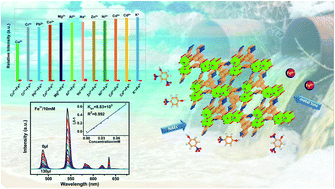A series of isostructural lanthanide metal–organic frameworks: effective fluorescence sensing for Fe3+, 2,4-DNP and 4-NP†
Abstract
Because of the fluorescence properties, lanthanide metal–organic framework (Ln-MOF) materials have potential applications in the detection of metal ions and nitro-aromatic explosives. Herein, a series of isostructural Ln-MOFs [Ln2(PIA)3(DMF)3(CH3OH)] (JLU-MOF201-Ln, Ln = Y, Tb, Yb, Ho and Er, H2PIA = 5-(1H-pyrazol-3-yl)isophthalic acid), and DMF = N,N-dimethylformamide) were successfully synthesized. In these compounds, binuclear secondary building units (SBUs) are formed by two adjacent Ln3+ ions and H2PIA ligands, further linking together to build a 2D structure. The 2D framework can be simplified as a (3,4)-connected network with 3,4L83 topology. The luminescence sensing tests indicated that JLU-MOF201-Y and JLU-MOF201-Tb show high sensitivity for Fe3+, 2,4-dinitrophenol (2,4-DNP) and 4-hydroxyderricin (4-NP), respectively. JLU-MOF201-Y and JLU-MOF201-Tb also exhibit high selectivity for detecting Fe3+ among other metal ions in DMF solution. The limits of detection (LOD) toward Fe3+, 2,4-DNP, and 4-NP are calculated to be 2.21, 0.46, and 1.15 μM for JLU-MOF201-Y and 2.17, 2.29, and 1.01 μM for JLU-MOF201-Tb, respectively.



 Please wait while we load your content...
Please wait while we load your content...